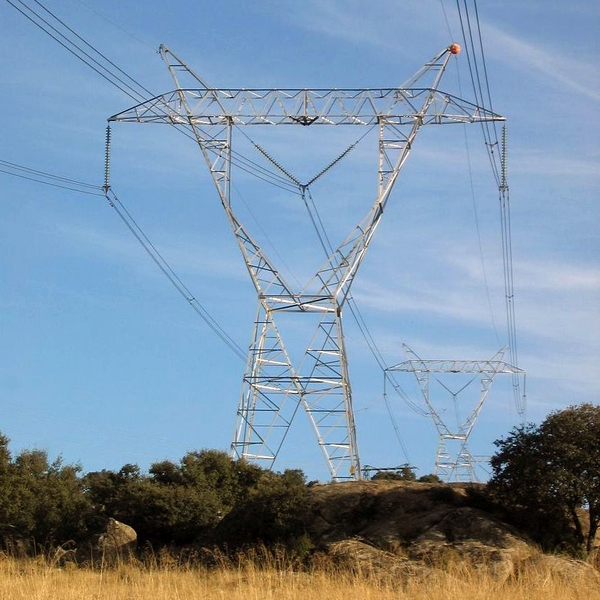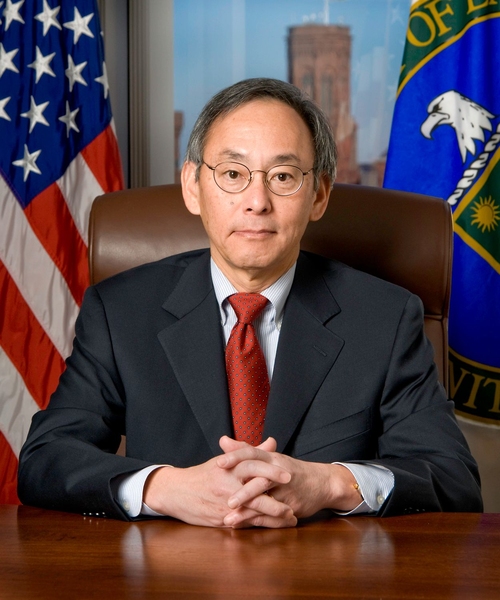In a talk rich with historical examples, U.S. Secretary of Energy Steven Chu made a strong case Wednesday that the right policies — and concerted efforts by the nation’s engineers and scientists — could once again produce significant growth in domestic manufacturing jobs, while addressing global problems of energy supply and climate change.
In his talk at MIT, Chu delivered a history of “transformative technologies,” including the invention of artificial fertilizer and the “Green Revolution,” which together unleashed explosive growth in world food production; the creation of the automotive assembly line by Henry Ford, which made cars available to the mass market; and the invention of the transistor and integrated circuits at Bell Labs, which unleashed the digital revolution that has transformed people’s lives in countless ways.
What the United States needs now, he said, is new transformative technologies in energy, especially ones that could boost the competitiveness of renewable, carbon-free technologies.
“Congress was outraged,” Chu said, charging that the government shouldn’t have been “picking winners” with federal funds. “Some things never change,” he added.
And yet, he pointed out, it was ultimately government funding that rescued aeronautical technology and made the United States the world leader in that growing industry. Europe dominated airplane production for much of the early 20th century, but it was heavy U.S. military and post office investment that made the commercial aviation industry possible — and made the United States the world leader in that field.
Taking that example to heart, Chu said, Americans should not regret that solar panels were invented here but are now mostly made in China. “They’re Henry Fording us,” he said of the Chinese innovations that lowered the cost of solar-panel production. But in that fast-developing field, there are still many opportunities to regain the lead, he suggested.
The potential for innovation that could revitalize American manufacturing extends across many sectors, Chu said. For example, improved steel alloys can allow car bodies to be just as strong but much lighter. This means that the engine and drive train can be smaller and lighter, since they don’t have to move as much weight, which in turn lowers the overall weight even more. In total, he said, cars could become 25 to 30 percent lighter, with essentially no sacrifice in size or performance. Similarly, new ways of processing composite materials for car bodies at much lower cost could achieve even greater improvements.
Another area where major improvements could be made, Chu said, is in the energy efficiency of buildings. He cited a new Obama administration initiative calling for a 20 percent reduction in energy use by commercial and academic buildings. “Most of the technology to improve the efficiency of buildings doesn’t cost any more,” and where there is an added cost, he said, it could be recouped in less than 10 years through energy savings.
Chu offered several other examples of specific technologies that could lead to major reductions in energy use. For example, operating electrical transmission lines at a higher frequency than the now-standard 60 hertz could allow for drastic reductions in the size and cost of transformers and power circuits, but doing so would require advances in power-conversion technology.
“There’s a theme here,” he pointed out: Engineering a few new materials or systems could make a big difference in meeting our energy challenges.
“America has a chance to lead the world in the clean-energy race,” he said. “We remain the most inventive nation in the world, but that’s not good enough.” New technology should not just be invented here, “it should be made in America. This will be the seeds of our future prosperity.”
Chu’s talk, organized by the student-run MIT Energy Club and the MIT Energy Initiative, was delivered Wednesday to an enthusiastic crowd at MIT’s Kresge Auditorium. After the talk, Chu met for a private lunch discussion with students and faculty.
In her introduction to Chu’s talk, MIT President Susan Hockfield praised the seven-year-old Energy Club, saying that the group — by far the Institute’s largest organization with an “astonishing” 3,400 members — “has profoundly shaped what we do around energy” and has helped to turn MIT “into a hotbed of innovation” in the energy arena.
As one indicator of the club’s success in spurring MIT graduates into leadership positions in energy, Hockfield mentioned that the club’s founding president, David T. Danielson PhD ’08, has now been nominated to serve as assistant secretary for energy efficiency and renewable energy at the U.S. Department of Energy.
Hockfield also praised Chu for his leadership of the DoE, saying that since his arrival the department has led “the largest and most important investment in science and technology since the Apollo program.”
In his talk at MIT, Chu delivered a history of “transformative technologies,” including the invention of artificial fertilizer and the “Green Revolution,” which together unleashed explosive growth in world food production; the creation of the automotive assembly line by Henry Ford, which made cars available to the mass market; and the invention of the transistor and integrated circuits at Bell Labs, which unleashed the digital revolution that has transformed people’s lives in countless ways.
What the United States needs now, he said, is new transformative technologies in energy, especially ones that could boost the competitiveness of renewable, carbon-free technologies.
- Video: Watch the event on TechTV
“Congress was outraged,” Chu said, charging that the government shouldn’t have been “picking winners” with federal funds. “Some things never change,” he added.
And yet, he pointed out, it was ultimately government funding that rescued aeronautical technology and made the United States the world leader in that growing industry. Europe dominated airplane production for much of the early 20th century, but it was heavy U.S. military and post office investment that made the commercial aviation industry possible — and made the United States the world leader in that field.
Taking that example to heart, Chu said, Americans should not regret that solar panels were invented here but are now mostly made in China. “They’re Henry Fording us,” he said of the Chinese innovations that lowered the cost of solar-panel production. But in that fast-developing field, there are still many opportunities to regain the lead, he suggested.
The potential for innovation that could revitalize American manufacturing extends across many sectors, Chu said. For example, improved steel alloys can allow car bodies to be just as strong but much lighter. This means that the engine and drive train can be smaller and lighter, since they don’t have to move as much weight, which in turn lowers the overall weight even more. In total, he said, cars could become 25 to 30 percent lighter, with essentially no sacrifice in size or performance. Similarly, new ways of processing composite materials for car bodies at much lower cost could achieve even greater improvements.
Another area where major improvements could be made, Chu said, is in the energy efficiency of buildings. He cited a new Obama administration initiative calling for a 20 percent reduction in energy use by commercial and academic buildings. “Most of the technology to improve the efficiency of buildings doesn’t cost any more,” and where there is an added cost, he said, it could be recouped in less than 10 years through energy savings.
Chu offered several other examples of specific technologies that could lead to major reductions in energy use. For example, operating electrical transmission lines at a higher frequency than the now-standard 60 hertz could allow for drastic reductions in the size and cost of transformers and power circuits, but doing so would require advances in power-conversion technology.
“There’s a theme here,” he pointed out: Engineering a few new materials or systems could make a big difference in meeting our energy challenges.
“America has a chance to lead the world in the clean-energy race,” he said. “We remain the most inventive nation in the world, but that’s not good enough.” New technology should not just be invented here, “it should be made in America. This will be the seeds of our future prosperity.”
Chu’s talk, organized by the student-run MIT Energy Club and the MIT Energy Initiative, was delivered Wednesday to an enthusiastic crowd at MIT’s Kresge Auditorium. After the talk, Chu met for a private lunch discussion with students and faculty.
In her introduction to Chu’s talk, MIT President Susan Hockfield praised the seven-year-old Energy Club, saying that the group — by far the Institute’s largest organization with an “astonishing” 3,400 members — “has profoundly shaped what we do around energy” and has helped to turn MIT “into a hotbed of innovation” in the energy arena.
As one indicator of the club’s success in spurring MIT graduates into leadership positions in energy, Hockfield mentioned that the club’s founding president, David T. Danielson PhD ’08, has now been nominated to serve as assistant secretary for energy efficiency and renewable energy at the U.S. Department of Energy.
Hockfield also praised Chu for his leadership of the DoE, saying that since his arrival the department has led “the largest and most important investment in science and technology since the Apollo program.”







